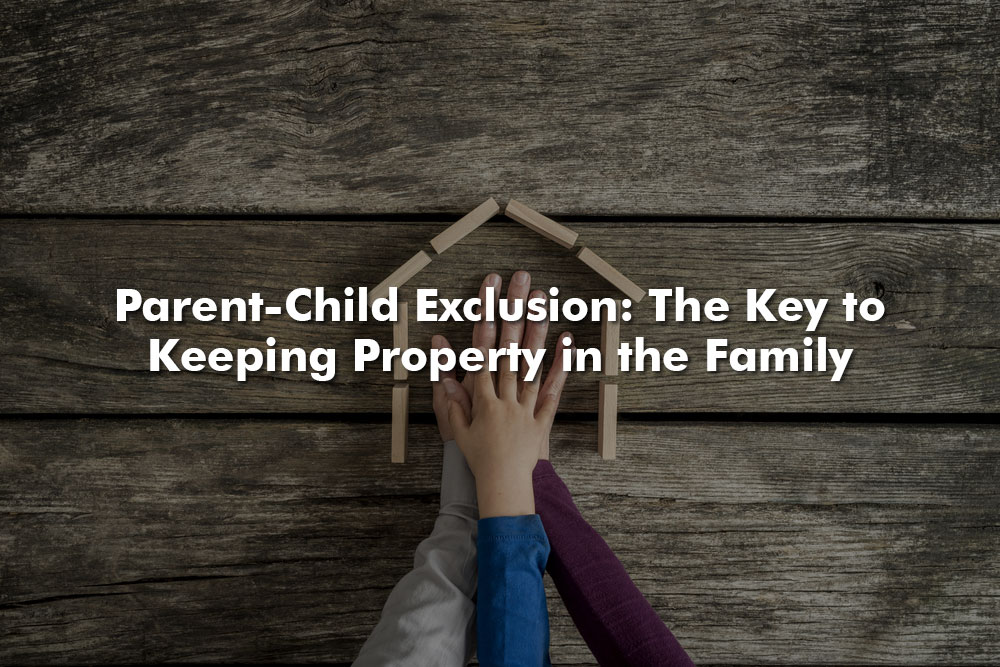For many San Diego families, real estate is more than just an asset—it’s a cornerstone of financial security, a legacy, and a home filled with memories. But when it comes time to pass that property on to the next generation, one major threat can undermine all of that: property tax reassessment. Fortunately, California law provides a tool to help families avoid that pitfall: the Parent-Child Exclusion.
What the Parent-Child Exclusion is, how it works, the impact of Proposition 19, and how smart estate planning can help you use this exemption to your family’s advantage. If you own property in California and want to keep it in the family, understanding this rule is essential.
What Is the Parent-Child Exclusion?
The Parent-Child Exclusion is a legal provision in California property tax law that allows certain transfers of real estate from parent to child without triggering a reassessment of the property’s value for tax purposes.
Normally, when a property changes hands—even by inheritance—county assessors reassess the property based on current market value. That can lead to massive increases in property taxes. The Parent-Child Exclusion is designed to protect families from this financial burden and preserve the lower tax base that was set when the parents originally purchased the property.
Proposition 13 and the Role of Reassessment
To understand the value of the Parent-Child Exclusion, we need to revisit Proposition 13, passed in 1978. Prop 13 limits property taxes in California to 1% of the property’s assessed value and restricts annual increases in assessed value to no more than 2% per year—unless there’s a change in ownership or new construction.
This means someone who purchased a home in the 1980s could be paying significantly lower property taxes than a neighbor who just bought a similar home today.
When a property is reassessed (usually at the time of transfer), the assessed value is reset to market value, which can increase the tax bill by thousands of dollars annually.
How the Parent-Child Exclusion Works (Pre and Post Prop 19)
Before Proposition 19 (Pre-February 2021)
Prior to February 16, 2021, the Parent-Child Exclusion allowed:
- Transfer of a primary residence of any value, with no limit, from parent to child without reassessment, regardless of whether the child lived in the home.
- Transfer of up to $1 million in assessed value of other property (like vacation homes or rental properties) per parent.
This gave families a powerful estate planning tool to keep both homes and income properties in the family with their original low tax basis intact.
After Proposition 19 (Post-February 2021)
Proposition 19 significantly changed the rules:
- Primary Residence Exclusion:
- Still allowed, but only if the child moves into the home and uses it as a primary residence within 12 months of transfer.
- Exclusion now capped at $1 million in market value above the assessed value. Any value above that is subject to reassessment.
- Rental and Vacation Homes:
- No longer eligible for the parent-child exclusion. These are fully reassessed at market value upon transfer.
Example:
Let’s say your home has an assessed value of $500,000, but its current market value is $1.5 million.
- If your child moves in and makes it their primary residence, only $1 million above the assessed value is excluded, so $1 million + $500,000 = $1.5 million total exclusion.
- If the market value is $1.7 million, the extra $200,000 will be reassessed at market value.
- If your child does not move in, the entire home is reassessed at the current market value.
Why This Matters for Your Family’s Future
In places like San Diego where property values have skyrocketed, property tax increases due to reassessment can make inherited homes unaffordable for your children—forcing them to sell a property they otherwise would have kept. That’s why smart planning is essential.
If you’re hoping to:
- Pass your family home to your children
- Keep rental or investment properties in the family
- Avoid unintentional tax burdens for your heirs
…you need a comprehensive estate plan that considers the impact of Proposition 19 and the updated Parent-Child Exclusion rules.
Common Mistakes That Trigger Reassessment
Many well-meaning parents unintentionally trigger reassessment by:
- Transferring the property during life without proper legal structure
- Leaving property through a will without considering Prop 19
- Failing to file the proper exclusion forms within the required time frame
- Assuming that trusts automatically avoid reassessment
It’s not enough to have a trust or will—the language and strategy matter.
Estate Planning Tools to Preserve Property Tax Benefits
1. Strategic Trust Planning
Setting up a revocable living trust can help you avoid probate, but to avoid reassessment, the trust must be crafted carefully—especially under Prop 19. For example, trusts can:
- Include provisions to ensure a child qualifies for the principal residence exclusion
- Coordinate timelines to ensure timely occupancy
- Provide specific instructions for claiming the exemption within the filing window
2. Advanced Legal Entities
While the Parent-Child Exclusion no longer protects investment properties, some families may benefit from forming LLCs or Family Limited Partnerships (FLPs) as part of a multi-generational wealth plan. These structures won’t shield you from reassessment, but they offer other benefits like:
- Asset protection
- Consolidated management
- Potential estate tax advantages
3. Gift and Sale Strategies
For high-net-worth families, structured gifts or sales to irrevocable trusts may be part of the plan, especially if the focus is long-term wealth transfer and asset preservation.
However, all of these strategies require careful legal and tax guidance to avoid pitfalls.
Filing for the Parent-Child Exclusion
To take advantage of the exclusion, your heirs must:
- Move into the inherited primary residence within 12 months of transfer.
- File a Claim for Reassessment Exclusion for Transfer Between Parent and Child (Form BOE-19-P) with the County Assessor’s Office.
- Provide proof of primary residence, such as a driver’s license, voter registration, and utility bills.
Failure to do this on time will result in a full reassessment of the property’s value, eliminating the benefits.
Key Takeaways
- Prop 19 dramatically limited the Parent-Child Exclusion, especially for rental and vacation homes.
- You can still protect your family home from reassessment, but only if your child moves in and files for the exclusion.
- Transferring real estate without smart planning can lead to huge tax increases for your children.
- The rules are strict and time-sensitive, so proactive planning is critical.
- Trusts, LLCs, and gifting strategies can still be useful tools when used correctly under legal guidance.
How We Can Help
At Allenby Law, we specialize in helping San Diego families plan smarter—not just for the future, but for lasting impact.
We understand how the Parent-Child Exclusion works under Prop 19, and we know how to integrate it into a comprehensive estate plan that simplifies the process while protecting your family’s home and financial well-being.
Whether you need to:
- Set up or update a trust
- Transfer your property without triggering reassessment
- Structure a long-term plan for multiple properties or children
—we’re here to guide you with clarity, care, and confidence.
Let’s protect your legacy, together. Schedule a consultation with Allenby Law today.



